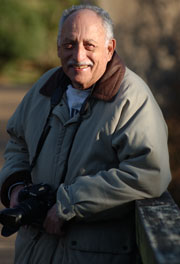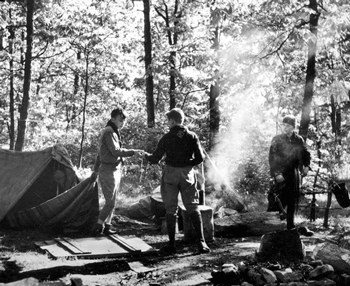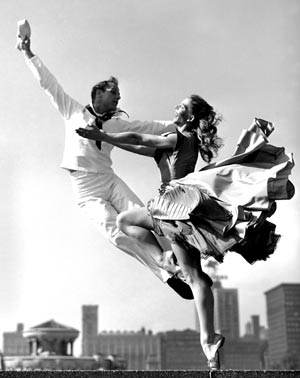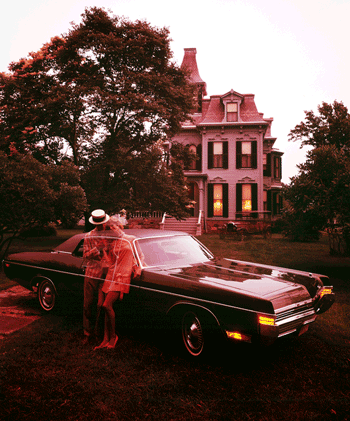 |
Bob Lerner: A Good Look
March 2003
|
 |
|||||||||
|
Robert Sherman Lerner was born in 1926 in Milwaukee, Wisconsin--without a camera in hand. He was just 10 when he discovered his father's old Kodak Autograph, and 13 when he won his first photo contest for his photographs of Boy Scouts camping in the north woods of Wisconsin. Perhaps more telling than the camping photographs, however, is his snapshot of a house after a snowstorm. Haunting in its illumination, the dwelling seems braced for nature's assault as frigid shadows flank its foundation. Shot in his teens, the image conveys a strong feeling of isolation, reminiscent of the houses painted by Edward Hopper.
Lerner's early interest in photography was encouraged by his family. He was allowed to establish a darkroom in his parent's house and used streetcars to toll across Milwaukee in pursuit of interesting photo subjects. In fact, his father, a gregarious businessman, introduced him to one of the great photographers of the period, Frank Scherschel. A luminary and pioneer in photojournalism, Scherschel was one of the developers of stroboscopic light for photography. When they met, Scherschel was a LIFE photographer based in Chicago. He had recently returned from the Grand Canyon on assignment for the magazine. 'Scherschel was brilliant. I had never seen photographs of higher quality than his work at the Grand Canyon. I took joy in his remarkable creativity, but was sure I'd never be able to take photos of such high quality. " From that moment, Scherschel became the fledgling photographer's mentor. It was a stupendous stroke of luck, Lerner acknowledges. After graduation from St. John's Military Academy in 1944, Lerner entered the U.S. Army, seeing World War II as a military policeman in occupied Germany. One of his fondest memories of overseas service was opening a gift package from Frank Scherschel--a new Rolleiflex camera, nearly impossible to obtain at the time. At war's end, Lerner returned to the states. He was 20 years old with no prospects. Scherschel told him about Francis Hugh Byrne, a colorful news photogrpaher who was retiring from the Chicago Tribune and about to open a studio in the Windy City. He needed an assistant.
In 1949, he and Dainie stored their belongings and headed for Europe where Lerner, who now hoped to be a photojournalist, intended to add to his portfolio with photographs which told vivid and dramatic stories. He achieved his goal. These photos, particularly the ones taken in Paris, were among his best. His sublime photograph in black and white of the Eiffel Tower, as viewed from the Trocadero, inspires with its geometric harmony and use of light and shade (The Tower on a Winter Afternoon, Paris, 1950). Upon the Lerner's return to Chicago a year later, Ben Wickersham, the bureau chief for Look, asked to see the European photos. Impressed, Wickersham offered him a job as the Look photographer in Chicago. Look rarely hired photographers a young as Lerner, who was now 25. His friends acknowledged the accomplishment by tossing a party for the couple. You can almost see the eyeballs in the word: Look. During the 20 years that Lerner worked for the biweekly magazine as a photographer, his eyes were certainly opened. He aimed his camera at astonishing scenes and remarkable people which his artistry translated into memorable photographs. His subjects ranged from presidents and movie stars to Indian rice farmers. His preference, however, was for stories with social significance. Lerner's photographs were used for 10 Look covers. His last, showcasing new cars from Detroit, was in 1972 when the magazine was nearing its end. In November of 1971, Look's editor William B. Arthur mailed a letter to Lerner reflecting with sadness and pride on publication of the final issue.In a handwritten message at the bottom he wrote: "We went out with the greatest set of automotive pictures ever made." Lerner's last auto cover was for the issue of September 21, 1971, and the last issue of Look was dated October 10, 1971.
Lerner and Dainie moved to Florida in the 80's. "My wife encouraged me in my work and raised a family without my being home the way a father should. We had a great marriage for 49 years." Shattered by his wife's death, Lerner moved to Yorktown, Virginia, in 1999 to be near his daughter, Sally, and her husband, Michael Lindsay. Since then, he has devoted more and more of his time to mentoring young photographers at various levels of development. "I want to spend the rest of my life teaching young people about photography, he says. And, Lerner continues to click his shutter. His latest project--photographing Norfolk's Granby Street--has produced new and, sometimes, stunning gifts. Bob Lerner may be contacted at robertlerner@cox.net
© Larry Maddry
|
||||||||||
|
Write a Letter to the Editor
Join our Mailing List
© The Digital Journalist
|


